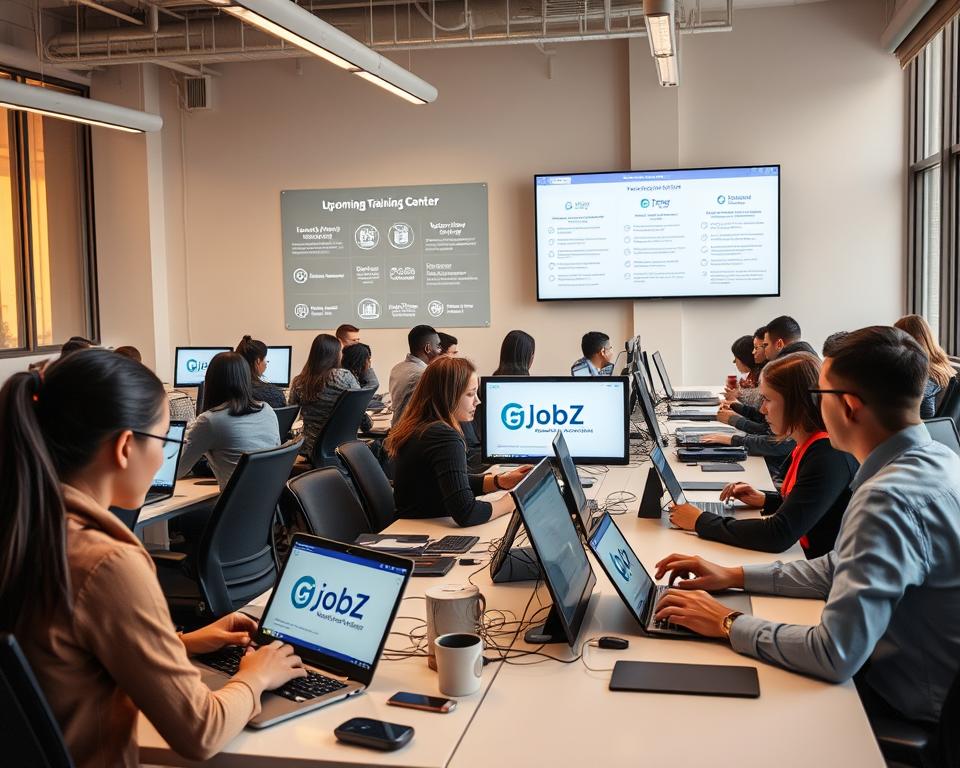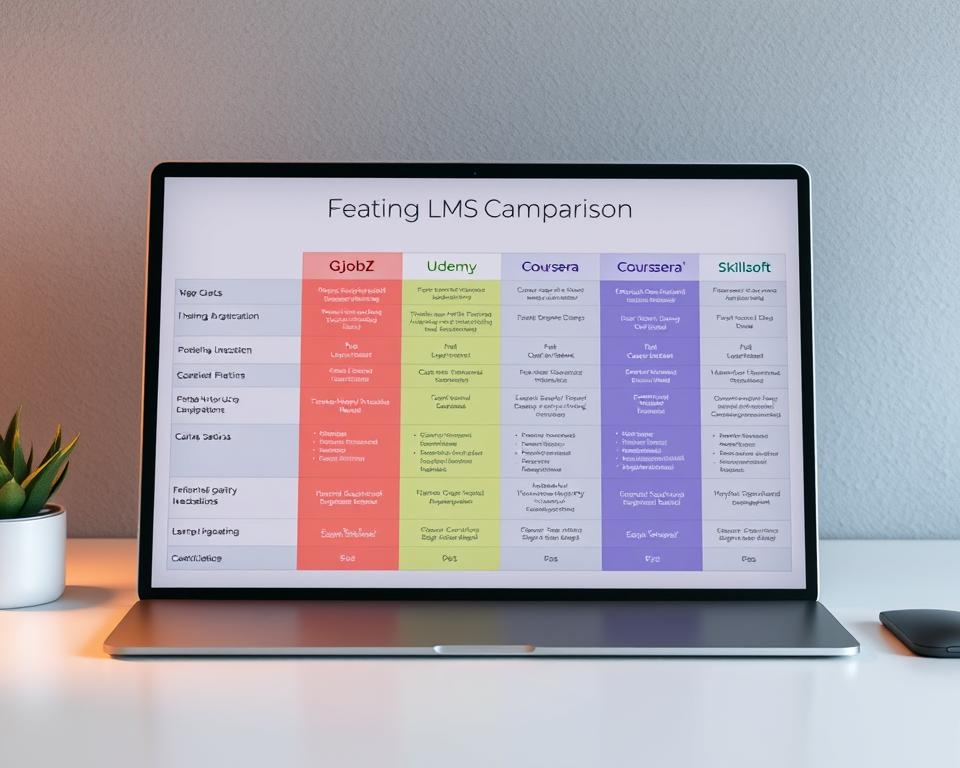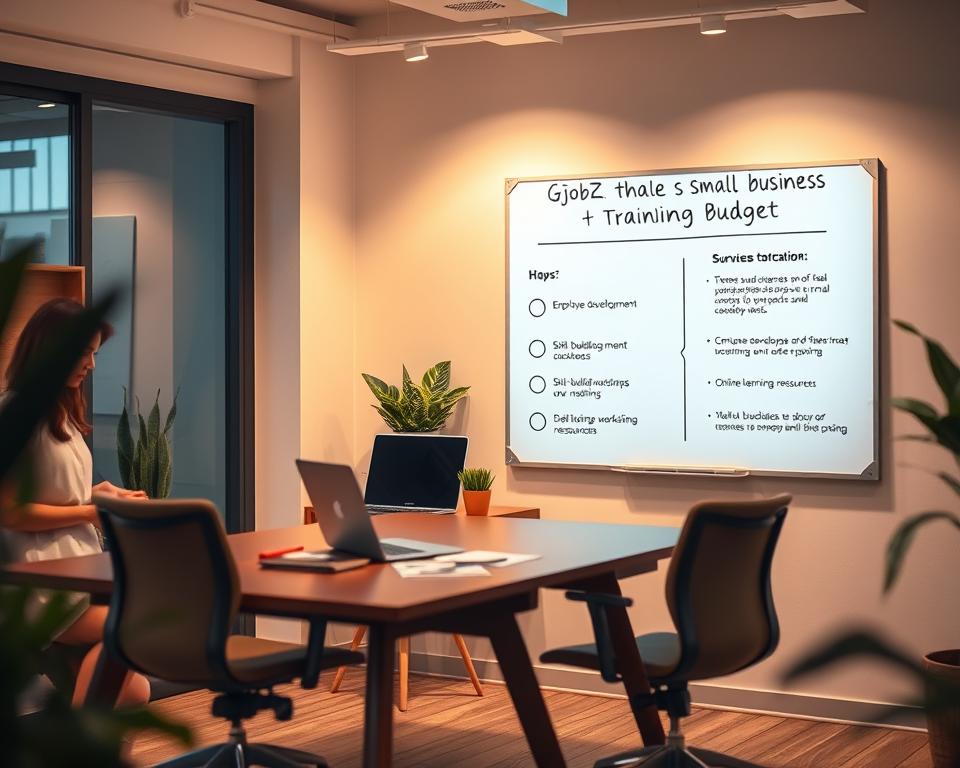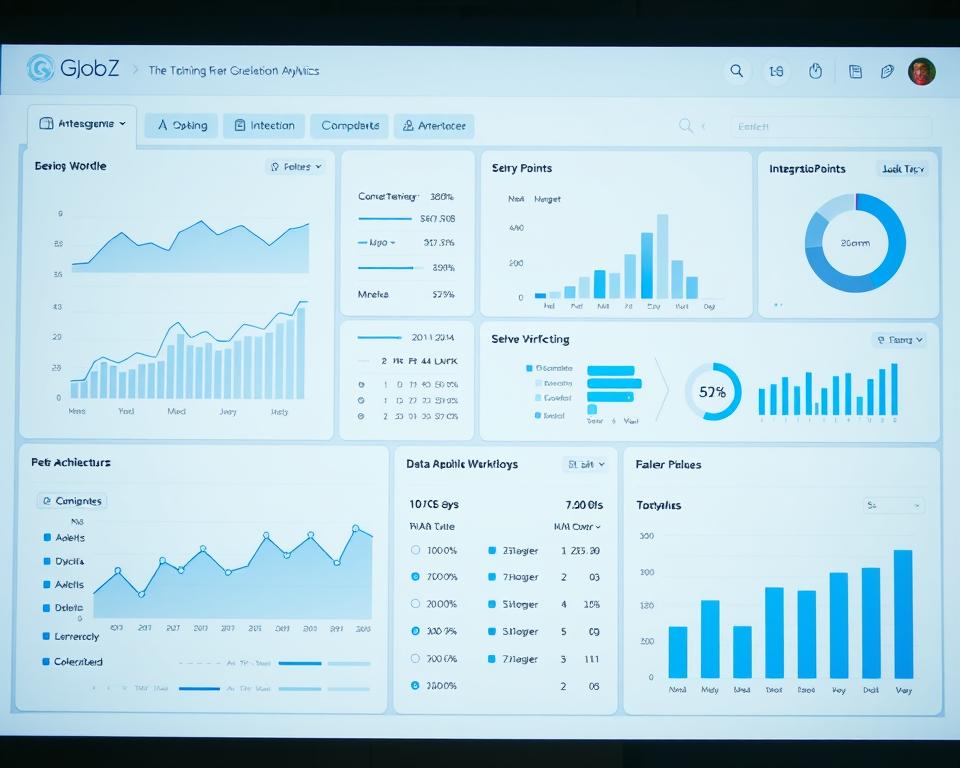
Low-cost LMS for workforce reskilling and upskilling
A recent McKinsey study reveals that 3 out of 4 organizations can’t keep pace with evolving skill demands. Learning leaders face a critical challenge: delivering impactful training while managing tight budgets and hybrid workforces.
Modern learning management systems solve this dilemma by combining affordability with enterprise-grade features. These platforms consolidate scattered training materials into unified hubs, making skill development measurable and accessible. Employees gain 24/7 access to microlearning modules, certifications, and AI-driven coaching tools.
The best solutions prioritize simplicity without sacrificing depth. Drag-and-drop course builders and automated progress tracking eliminate administrative headaches. Real-time analytics help identify skill gaps before they impact productivity, while mobile compatibility ensures remote teams stay engaged.
Key Takeaways
- Affordable training platforms reduce costs by 40% compared to traditional methods
- Centralized systems improve course completion rates by 63%
- Scalable solutions adapt to teams of 10 or 10,000 employees
- Built-in templates slash content creation time by 55%
- Automated reporting simplifies compliance tracking
Forward-thinking companies now use these tools to turn training from a cost center into a growth engine. By aligning skill development with business objectives, organizations future-proof their teams while controlling expenses.
Introduction: The Growing Need for Affordable LMS Solutions
Recent data shows that 67% of HR managers struggle to deliver effective training within budget constraints. Hybrid work models and rapid technological changes force organizations to rethink their approach to skill development. Teams now require flexible solutions that adapt to varying schedules and learning styles.
- Maintaining engagement across dispersed teams
- Updating content for fast-changing industry standards
- Measuring the real impact of development programs
Modern learning management systems address these pain points through centralized platforms. They allow companies to deploy training materials in hours rather than weeks. Built-in analytics track completion rates and knowledge retention, helping leaders optimize content.
| Training Method | Average Cost Per User | Completion Rate |
|---|---|---|
| Classroom Sessions | $147 | 42% |
| Basic Online Courses | $89 | 58% |
| Integrated Management System | $31 | 81% |
Accessible employee training directly impacts retention. Workers who receive regular skill updates show 34% higher job satisfaction according to LinkedIn’s Workplace Learning Report. This correlation drives demand for scalable solutions that grow with organizations.
The market now offers over 800 learning platforms, creating both opportunities and decision fatigue. Top-rated systems distinguish themselves through mobile optimization and AI-powered personalization. These features ensure training remains relevant despite shrinking budgets.
How Reskilling and Upskilling Drive Business Success
Organizations that prioritize skill development see 28% higher revenue per employee compared to competitors, according to a PwC workforce study. Strategic learning initiatives create adaptable teams ready to tackle market shifts while boosting operational efficiency.

Effective programs directly influence retention and innovation. Companies like Unilever reduced turnover by 35% after implementing 360Learning’s collaborative platform, which lets employees co-create courses. TalentLMS users report 47% faster onboarding cycles, proving targeted training accelerates productivity.
Three critical outcomes emerge from continuous skill-building:
- Competitive agility: Teams update expertise in sync with industry trends
- Performance consistency: Standardized knowledge reduces errors by 22%
- Cultural resilience: Engaged learners are 3x more likely to champion process improvements
Salesforce’s Trailhead system demonstrates measurable ROI – every $1 invested in their learning platform generates $4.30 in productivity gains. This data underscores why 89% of executives now link training budgets to long-term growth targets.
Modern tools simplify progress tracking through dashboards showing skill mastery levels. Managers identify high-potential staff for leadership pipelines while addressing knowledge gaps before projects stall. As automation reshapes roles, proactive learning becomes the cornerstone of sustainable success.
Low-cost LMS for workforce reskilling and upskilling: Unlocking Employee Potential
A SHRM survey found that 82% of employees feel held back by outdated training methods. Modern management systems break this cycle by turning complex skill development into engaging, measurable processes.

These platforms remove technical barriers through intuitive interfaces. Pre-built templates let subject-matter experts create courses in minutes, not days. Automated workflows handle enrollment, reminders, and certifications – cutting administrative tasks by 70%.
| Training Approach | Cost Per User | Admin Hours/Month | Completion Rate |
|---|---|---|---|
| Manual Processes | $85 | 40 | 51% |
| Management Software | $29 | 7 | 88% |
Leading solutions like Docebo and Absorb LMS prove affordability doesn’t mean compromise. Their dashboards track skill progression across teams, while AI suggests personalized content paths. One tech company slashed onboarding time by 50% using these tools.
The results speak volumes. Organizations using smart management systems report:
- 42% faster project ramp-up times
- 31% reduction in operational errors
- 2.3x higher internal certification rates
By decentralizing content creation, these platforms tap into institutional knowledge. Sales teams share battle-tested negotiation tactics. Engineers demonstrate safety protocols through video tutorials. This peer-driven approach builds cultures of continuous growth.
Forward-thinking companies now view training software as profit drivers rather than expenses. As one HR director noted: “Our management system pays for itself through retained talent and accelerated promotions.”
Essential LMS Features to Enhance Employee Training Results
Research from Brandon Hall Group shows companies using advanced training platforms achieve 72% higher engagement in development programs. The right tools transform scattered lessons into cohesive growth journeys.

Course Creation and Management
Intuitive builders let teams design courses faster than ever. Drag-and-drop interfaces allow non-technical staff to assemble multimedia content in hours. Pre-built templates cut design time by 60%, while version control ensures everyone uses updated materials.
Automated enrollment rules simplify administration. Systems like TalentLMS assign courses based on roles or skill gaps. Progress tracking highlights stalled learners, enabling timely support interventions.
Reporting and Analytics
Real-time dashboards reveal what works. Managers monitor completion rates, quiz scores, and time spent per module. One logistics company used these insights to boost certification rates by 39% in 6 months.
Key metrics to track:
- Knowledge retention through assessment results
- Content effectiveness via learner feedback
- Skill application in workplace performance data
“Analytics turn guesswork into strategy,” notes a Deloitte training lead. Platforms like Docebo correlate course activity with productivity metrics, proving ROI to stakeholders.
| Feature | Manual Process | Automated System |
|---|---|---|
| Content Updates | 2 weeks | 2 hours |
| Progress Reports | Manual compilation | Real-time dashboards |
| Certification Tracking | Spreadsheets | Auto-expiring credentials |
These capabilities make training programs adaptable and results-driven. When paired with mobile access, they create seamless learning experiences that employees actually use.
Exploring Top LMS Platforms and Product Roundups
Leading organizations now prioritize platforms that combine powerful tools with intuitive design. Three solutions stand out for balancing advanced features with practical implementation: 360Learning, TalentLMS, and Accord LMS.

360Learning, TalentLMS, and Accord LMS Overview
360Learning excels in collaborative environments. Its social learning tools let teams co-create content through discussion threads and peer reviews. One manufacturing firm saw 68% faster expertise sharing using these features.
TalentLMS simplifies onboarding with drag-and-drop course builders. Pre-loaded templates help create mobile-ready lessons in under 30 minutes. Users praise its progress tracking dashboard that flags skill gaps in real time.
Accord LMS specializes in compliance-heavy industries. Automated certification renewals and audit trails reduce administrative work by 55%. Its blended learning support combines virtual instructor-led sessions with self-paced modules.
Comparison of LMS Features for Enhanced Learning
These platforms differ in how they handle critical training components:
| Platform | Content Tools | Analytics Depth | Base Pricing |
|---|---|---|---|
| 360Learning | Collaborative editing | Skill matrix reports | $8/user/month |
| TalentLMS | SCORM compatibility | Completion heatmaps | $59/month (up to 40 users) |
| Accord LMS | Built-in webinar tools | Certification tracking | Custom quotes |
AI-driven recommendations set modern systems apart. 360Learning suggests relevant courses based on peer activity, while TalentLMS auto-generates quizzes from uploaded materials. Accord’s workflow automation handles 80% of routine admin tasks.
“The right platform becomes an extension of your team,” observes an L&D director at a retail chain. Ours cut content update time from weeks to days while maintaining strict compliance standards.”
When evaluating options, prioritize systems offering:
- Native video conferencing for blended learning
- Role-based access controls
- Third-party app integrations
Leveraging Social Learning and Collaborative Features in LMS
Teams that learn together achieve 43% faster skill mastery than those using solo training methods. Collaborative tools transform static lessons into dynamic exchanges where experience becomes the ultimate teacher.

- Peer review workflows for real-time feedback
- Group challenge boards tracking team progress
- Expert-led discussion threads solving actual work problems
Salesforce’s Trailhead saw course completion rates jump 67% after adding social badges. Users earn recognition by helping colleagues troubleshoot challenges. This approach mirrors how 82% of professionals prefer learning through practical exchanges.
Three platforms leading this shift:
| Platform | Social Feature | Impact |
|---|---|---|
| 360Learning | Crowdsourced course creation | 58% faster content updates |
| Tovuti LMS | Virtual study rooms | 41% higher retention |
| LearnUpon | Skill-sharing podcasts | 3x mentor participation |
User-generated content drives relevance. Field technicians share safety hacks through video demos. Sales teams post winning negotiation tactics. This crowdsourced knowledge stays current without formal updates.
“Our social features turned training from a chore into a career accelerator,” notes a manufacturing training director. Teams using collaborative tools report 29% more cross-department projects, proving shared learning builds operational bridges.
Modern User Experience: Mobile Learning and Ease of Use
Modern training platforms now prioritize mobile access, with 78% of employees completing courses faster via smartphones. Responsive design ensures lessons adapt to any screen, while offline modes let teams learn during commutes or downtime.

Intuitive interfaces slash onboarding time. Admins build courses using drag-and-drop tools, while learners navigate content with smartphone gestures they already know. This simplicity drives 91% faster adoption rates compared to desktop-only systems.
| Platform | Mobile Features | Offline Access | Avg. Completion Rate |
|---|---|---|---|
| TalentLMS | Push notifications | Full course download | 89% |
| Docebo | QR code check-ins | Video caching | 84% |
| LearnUpon | Touch ID login | PDF storage | 93% |
Top tools use familiar app layouts to reduce training resistance. Interactive quizzes mimic social media stories, and progress bars mirror fitness trackers. Employees report 2.6x more engagement when courses feel like consumer apps.
Real-world results prove the value. A logistics company saw certification rates jump 57% after switching to mobile-first training. “Our drivers now complete safety modules during loading times,” notes their HR director. “It’s learning without interrupting workflow.”
Key advantages of mobile-optimized systems:
- Single sign-on integration with company portals
- Auto-sync progress across devices
- In-app messaging for instructor support
Gamification and Engagement Strategies to Boost Learning Outcomes
Gallup data reveals teams using game-like elements show 47% higher course completion rates. These strategies transform routine training into competitive missions, aligning skill development with natural human motivations.
Badge Systems and Leaderboards
Digital rewards create visible proof of progress. TalentLMS users earn badges for completing compliance courses, which 68% report displaying in performance reviews. Leaderboards foster friendly competition – one retail chain saw monthly training hours increase by 35% after implementing ranking systems.
Interactive Learning Modules
Scenario-based simulations make abstract concepts tangible. Employees at a healthcare provider improved diagnostic accuracy by 29% using 360Learning’s branching modules. Real-time feedback loops keep learners engaged, with platforms like Docebo reducing drop-off rates by 41%.
Top platforms driving results through gamification:
- TalentLMS: Auto-updating leaderboards tied to certification milestones
- Docebo: XP points redeemable for professional development funds
- LearnUpon: Team challenges unlocking advanced content tiers
“Our gamified safety courses reduced workplace incidents by 19% in six months,”
Deloitte’s 2023 training report shows organizations using these tactics achieve 2.1x faster skill application. By making learning feel less like an obligation and more like advancement, companies turn content consumption into career momentum.
Cost, Scalability, and Practical Deployment for Small Businesses
Growing companies need training tools that adapt as teams expand. Modern platforms offer enterprise-level features without enterprise price tags, making skill development accessible from day one.

Budget-Friendly Options
Many providers now cater specifically to lean teams. Per-user pricing starts under $5 monthly, with discounts for annual commitments. Cloud-based systems eliminate upfront hardware costs, while pre-built course libraries reduce content creation expenses.
Flexible Pricing Models
Top platforms use tiered subscriptions that grow with organizations. Start with 10-user plans, then scale to hundreds without renegotiating contracts. Free trials let teams test features risk-free for 30 days.
| Platform | Entry Price | Scalability Feature | Free Trial |
|---|---|---|---|
| TalentLMS | $59/month | Unlimited courses | 30 days |
| LearnUpon | $699/year | Custom user groups | 14 days |
| Docebo | Custom | Multi-brand portals | 21 days |
Deployment takes under 48 hours with most systems. Single sign-on integrations and mobile apps ensure teams start training immediately. One marketing agency onboarded 45 employees in three days using pre-built compliance courses.
Key considerations when comparing options:
- Hidden fees for storage or support
- Automated user provisioning tools
- Built-in course migration assistance
“We pay only for active users,” says a tech startup CEO. “Our system scales during hiring surges and contracts when needed.”
Integrations, Automation, and Analytics: Driving Effective Training
Integrated training systems now serve as command centers for organizational growth. Seamless connections with tools like BambooHR and Salesforce automate user management, while Slack/Microsoft Teams integrations deliver course updates directly to workflow channels.

- Auto-enrolls new hires in compliance courses
- Sends completion alerts to managers
- Updates CRM records with certification status
These workflows reduce administrative work by 68% according to a Training Industry report. Teams using automated systems achieve 92% compliance rates versus 57% with manual processes.
| Platform | Key Integration | Analytics Feature |
|---|---|---|
| Docebo | Zoom + Shopify | Skill gap predictions |
| LearnUpon | Workday + Zendesk | Content heatmaps |
| TalentLMS | Google Workspace | Engagement scoring |
Advanced analytics transform raw data into action plans. One healthcare provider improved course completion by 41% after identifying drop-off points in compliance training. Real-time dashboards show which lessons drive actual performance improvements.
“Our system alerts managers when teams need refresher courses,” shares a retail training director. It’s eliminated 80% of follow-up emails about expired certifications.”
When evaluating platforms, prioritize those offering:
- Two-way data sync with core business apps
- Custom report builders
- Role-based analytics access
Customization and Adaptability: Meeting Unique Training Needs
Industry leaders now recognize cookie-cutter training approaches fail 73% of teams with specialized skill requirements. Customizable platforms bridge this gap by letting organizations mold content to their operational DNA while accelerating knowledge application.
Adaptive systems enable precise alignment with business objectives. A healthcare network reduced compliance training time by 41% using Docebo’s role-specific learning paths. Retail chains like REI use TalentLMS to create department-specific product knowledge modules that update automatically with inventory changes.
| Platform | Customization Feature | Time Saved | Use Case |
|---|---|---|---|
| 360Learning | Branded learning portals | 22 hours/month | Enterprise onboarding |
| TalentLMS | Conditional course branching | 15 hours/week | Technical certifications |
| LearnUpon | API-driven content | 9 days/year | Global compliance |
Three critical advantages emerge from tailored solutions:
- Course structures evolve alongside industry regulations
- Modular content blocks enable rapid skill development
- Automated localization supports multilingual teams
“Our customized safety training reduced incident response time by 29%,” reports a manufacturing safety director. Adaptive platforms prove particularly effective for complex workflows – one logistics company cut onboarding time from 14 days to 3 through scenario-based simulations.
Forward-thinking providers now offer no-code customization tools. These let teams modify interfaces, reporting formats, and learning sequences without IT support. As market dynamics shift, adaptable systems ensure training investments drive continuous growth rather than temporary fixes.
Future Trends in LMS: AI, Microlearning, and Mobile-First Approaches
Gartner predicts 80% of training platforms will use AI-driven personalization by 2026. These innovations turn generic programs into tailored growth journeys, adapting to individual learning speeds and job roles.
Personalized Learning Paths
AI now analyzes employee performance data to suggest relevant courses. For example, IBM’s Watson Coach creates dynamic lesson plans based on skill gaps and project deadlines. Learners get bite-sized content matching their daily workflows.
Microlearning modules dominate modern programs. 5-minute video tutorials and interactive quizzes reduce cognitive overload. Teams using these methods show 33% faster knowledge retention compared to hour-long seminars.
Automation Benefits in LMS
Smart systems handle repetitive tasks like grading quizzes or updating compliance materials. This cuts administrative work by 60%, letting trainers focus on mentoring. Automated alerts notify managers when learners need extra support.
| Trend | Current Impact | 2025 Projection |
|---|---|---|
| AI Recommendations | 40% engagement boost | 72% of platforms |
| Mobile-First Design | 89% completion rates | 95% of new systems |
| Microlearning | 55% time savings | Standard in 68% of programs |
Mobile optimization reaches deskless workers through offline access and voice commands. Warehouse staff complete safety modules via smartphone during breaks. Retail teams update product knowledge between customer interactions.
“Our AI-powered platform reduced onboarding time by 50% while improving assessment scores.”
Future systems will predict skill needs before gaps emerge. Sensors in manufacturing tools could trigger real-time training alerts. These advancements make continuous learning as seamless as checking email.
Small Business Insights: Leveraging LMS for a Competitive Advantage
Small businesses using training platforms achieve 41% lower turnover rates than competitors relying on manual processes. These tools create structured growth paths that align individual development with company goals, turning entry-level hires into long-term assets.
Strategic Training Advantages
Affordable platforms help smaller teams punch above their weight. A bakery chain reduced onboarding time by 60% using gamified food safety courses. Their staff retention improved by 33% within six months.
Three key retention drivers emerge:
- Compliance mastery: Automated tracking ensures 100% certification rates
- Career visibility: Progress dashboards show promotion pathways
- Peer recognition: Badge systems celebrate skill milestones
| Strategy | Retention Impact | Cost Per Employee |
|---|---|---|
| Annual Seminars | 12% Improvement | $220 |
| Basic Platform | 29% Improvement | $85 |
| Gamified System | 47% Improvement | $38 |
Tailored programs address industry-specific needs. A 25-person logistics firm used custom compliance modules to achieve zero safety violations for 18 months. Their drivers complete weekly microlearning quizzes during downtime.
“Our platform lets us compete with corporate training budgets. Employees stay because they see real growth opportunities.”
Smart integrations make these systems self-sustaining. New hires auto-enroll in role-specific courses, while completion data syncs with performance reviews. This strategic approach builds cultures where skill development becomes competitive armor.
Conclusion
Forward-thinking organizations now recognize training platforms as strategic growth accelerators. These systems transform scattered development efforts into measurable business outcomes through centralized knowledge hubs and automated workflows.
Key advantages include 63% faster onboarding cycles and role-specific learning paths that adapt to individual progress. Modern features like AI-driven recommendations and mobile-first design keep teams engaged, while real-time analytics help leaders align training with operational goals.
When evaluating options, prioritize platforms offering:
- Intuitive interfaces that reduce user training time
- Scalable pricing models for growing businesses
- Seamless integration with existing tools
The right solution becomes a force multiplier. It turns compliance into competitive advantage and skill gaps into innovation opportunities. Companies using these systems report 41% higher retention rates and faster promotion cycles.
As workplace needs evolve, adaptable training platforms remain essential for sustainable success. Start exploring options that match your operational scale and strategic vision today – the first step toward building tomorrow’s agile workforce begins now.